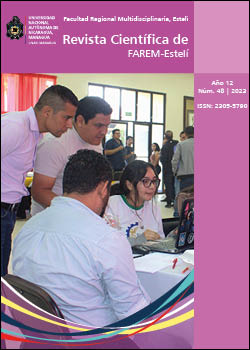Working conditions and perception of occupational risks of the staff of a clinical laboratory in Managua, Nicaragua, January 2023
DOI:
https://doi.org/10.5377/farem.v12i48.17505Keywords:
Occupational risks, working conditionsAbstract
The purpose of this article is to identify the working conditions and perception of occupational risks of the personnel in a clinical laboratory in the city of Managua during January 2023. It is a descriptive study with a cross-sectional quantitative approach where the study area was the laboratory itself. The universe and the sample were 15 collaborators from different work areas. A structured questionnaire survey with closed questions was applied to the collaborators, in which they were asked about the social and labor factors, as well as their perception of the risks (physical, chemical, biological, psychosocial and ergonomic). A structured checklist was used based on the observation of the structures and conditions of the clinical laboratory in the different areas evaluated. Inferential statistics were used for the perception of risk level by means of Pearson’s Chi-square descriptive statistical method. The data analysis of the socio-labor characteristics showed that the majority of the population is female, aged 20 to 30 years, and most of them have been working for 2 to 5 years. The different areas (86.7%) comply with biosafety standards. Most of the collaborators perceived all the risks, with greater frequency in the medical care and laboratory areas, with a predominance in both of them of the biological risk, due to exposure to body fluids. In relation to risk perception, biological risk predominated (high level), followed by ergonomic and psychosocial risk (moderate risks), with physical and chemical risks rated as low risk. Significance was only observed when contrasting the biological risk with the working conditions present, related to the occupational risks involved in the handling of diverse biological material and samples typical of this type of activity.
Downloads
References
Barrios, N. (2015). Cumplimiento de la norma de bioseguridad por parte del personal de enfermería en el hospital Masaya servicios médicos especializados S.A. Marzo 2015. Centro de investigaciones y estudios de la salud, 0(0), 1–78. http://repositorio.unan.edu.ni/5209/1/t43.pdf
Beltrón, F. (2020). Riesgos biológicos en los laboratorios clínicos de la ciudad de Portoviejo mediante el método Biogaval. DOI: http: 10.36097/rsan.v1i40.1418
Benavides, C. (2021). Riesgos laborales a los que estan expuestos los trabajadores de laboratorio y distribuidora el Carmen S.A (Discarsa) durante el mes de junio 2021. https://repositorio.unan.edu.ni/17719/
González, et al. (1999). Manual Básico de Prevención de Riesgos Laborales (pp. 1–237).
Ley 618, Ley General de Higiene y Seguridad del Trabajo, 133 (2007). www,lagaceta.gob.ni
Hämäläinen, P. (2017). Global estimes of occupational accdents and work-related illnesses 2017. In Workplace safety and health institute. https://doi.org/10.1109IECON.2006.347617
INIDE. (2021). Anuario estadistico 2021.
INSS, I. N. de S. S. (2020). Anuario Estadistico. https://inss-princ.inss.gob.ni/
Ley 185 Código del Trabajo, 205 (1996). https://www.poderjudicial.gob.ni/
Miñano, S. (2020). Condiciones de trabajo y riesgos laborales en los trabajadores del area de expedicion de la empresa AKM S.A. C.
Acuerdo Ministerial JCHG-000-08-09. Procedimiento técnico de higiene y seguridad para la evaluacion de riesgo en los centros de trabajo, (2007). https://www.academia.edu/39266727/Acuerdo_Ministerial_Evaluación_de_riesgo
Noelia, G., & Molinares, R. (2020). Riesgos laborales de los colaboradores de empresa bordatextil, león, nicaragua. febrero 2020.
Norma técnica sobre las disposiciones mínimas de higiene y seguridad de “los equipos de protección personal”, 21 (1996). http://legislacion.asamblea.gob.ni.
Organización Mundial de la Salud (1983). Tercera edición. In Manual De Bioseguridad En El Laboratorio. (Vol. 3).
Organización Mundial de la Salud (1995). Salud Ocupacional para Todos, Estrategia Mundial.
Organizaçion Internacional do Trabalho (OIT). (2013). La {Prevención} de las enfermedades profesionales.http://natlex.ilo.ch/wcmsp5/groups/public/---ed_protect/---protrav/---safework/documents/publication/wcms_209555.pdf
Organización Internacional del Trabajo [OIT]. (2019). Seguridad y salud en el centro del futuro del trabajo. Aprovechar 100 años de experiencia. In Sistema de Gestión. http://training.itcilo.it/actrav_cdrom2/es/osh/kemi/pest/pesti2.htm
Pérez, M. y Crespo, D. (2014). Bioseguridad en los laboratorios de salud. Correo científico
médico de Holguín. 18 (1). http://www.scielo.sld.cu/pdf/ccm/v18n1/ccm15114.pdf
Pérez, Y., Pedroso, L., & Pérez, L. (2020). Evaluación del riesgo biológico en laboratorio clínico aplicando el método BIOGAVAL. Medimay, 27(2), 104–116.
Richmond, J. (2017). Bioseguridad en laboratorios de microbiología y biomédica. Centers for Disease Control and Prevention National Institutes of Health, 4, 1–196. https://www.uib.cat/digitalAssets/195/195210_cdc_bmbl_4.pdf
Sabastizagal-Vela, I., & Benavides, F. (2020). Condiciones de trabajo, seguridad y salud en la población económicamente activa y ocupada en áreas urbanas del Perú. Rev. Perú Med Exp Salud Pública, 37(1), 32–41.
Vázquez, A., Ayala, I., Domenech, I., Martínez, I. y Rodríguez, R. (2019). Riesgo biológico en los laboratorios de Microbiología de las instituciones de salud. Rev. Panorama. Cuba y Salud [Internet] 14(1):61-67. http://www.revpanorama.sld.cu/index.php/rpan/article/view/
Published
Issue
Section
License
Copyright (c) 2024 Revista Científica de FAREM-Esteli

This work is licensed under a Creative Commons Attribution-NonCommercial-ShareAlike 4.0 International License.



